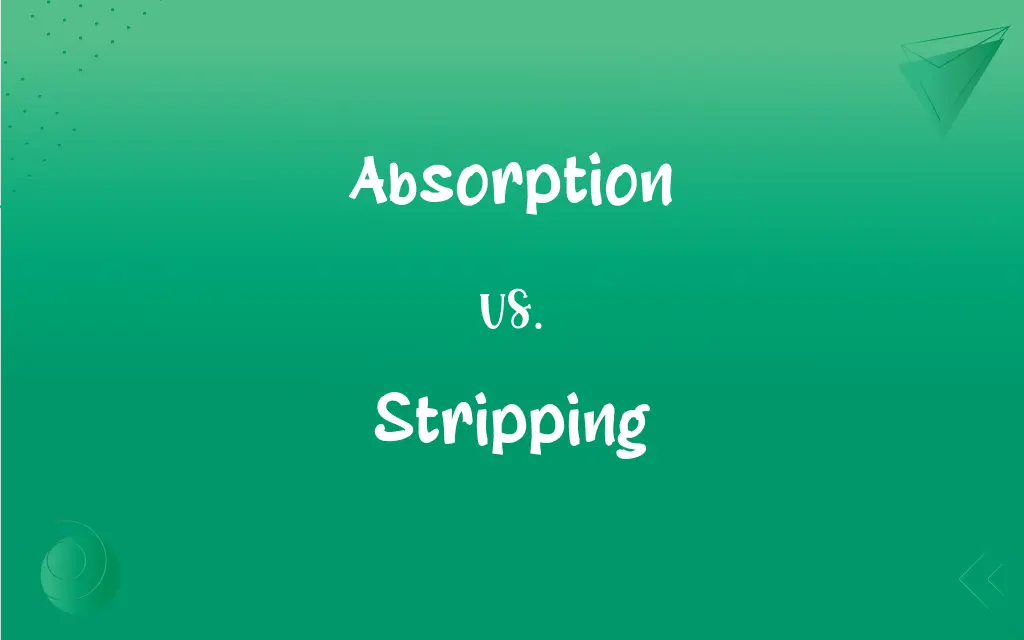Absorption vs. Stripping: What's the Difference?
Edited by Harlon Moss || By Janet White || Published on March 2, 2024
Absorption is the process of a substance being taken in or soaked up, while stripping is the removal of a component from a mixture, typically using a solvent or heat.

Key Differences
Absorption refers to the process in which one substance becomes incorporated into another, such as a liquid being absorbed by a solid. It is a key process in various scientific and industrial applications. On the other hand, stripping involves the removal or separation of one or more components from a mixture, often seen in chemical processing industries.
In absorption, the substance being absorbed, known as the absorbate, diffuses into the absorbing material, the absorbent. This process is vital in applications like water purification and gas absorption. Stripping, conversely, is used to remove unwanted components from a mixture, such as removing impurities from a liquid using steam or another gas.
The mechanism of absorption can involve physical or chemical processes, depending on the nature of the substances involved. In the case of stripping, the technique generally relies on the difference in volatility or affinity of the components in the mixture.
Absorption is often utilized in environmental engineering to remove pollutants from air or water. Stripping, in contrast, is frequently used in the petrochemical industry to purify products or recover solvents.
Both absorption and stripping are critical in the chemical engineering field, yet they serve opposite functions: absorption for incorporating substances and stripping for removing them.
ADVERTISEMENT
Comparison Chart
Primary Function
Incorporating a substance into another
Removing a component from a mixture
Common Usage
Water and air purification
Purification in petrochemical processes
Mechanism
Diffusion of absorbate into absorbent
Utilizing volatility or affinity differences
Industrial Applications
Environmental engineering
Chemical processing industries
Process Nature
Can be physical or chemical
Primarily physical separation
ADVERTISEMENT
Absorption and Stripping Definitions
Absorption
It's used in various scientific and industrial applications.
Sound absorption materials are used to reduce noise in buildings.
Stripping
Stripping is the process of removing components from a mixture.
Steam stripping is used to remove volatile compounds from wastewater.
Absorption
Absorption can be either a physical or chemical process.
The absorption of sunlight by plants is essential for photosynthesis.
Stripping
Stripping is used in chemical processing industries.
Solvent stripping is essential in purifying pharmaceutical products.
Absorption
Absorption involves a substance diffusing into another.
The absorption of nutrients in the intestines is crucial for digestion.
Stripping
It often employs solvents or heat for separation.
Air stripping removes contaminants from groundwater.
Absorption
It occurs when a material takes in another substance.
Carbon filters rely on absorption to remove impurities from water.
Stripping
It typically involves separating substances based on volatility.
Stripping gases from oil involves heating the mixture.
Absorption
Absorption is the process of soaking up or incorporating a substance.
The sponge's absorption of water is due to its porous structure.
Stripping
Stripping is a physical separation technique.
Stripping paint from furniture involves applying a chemical solvent.
Absorption
The act or process of absorbing or the condition of being absorbed.
Stripping
To remove clothing or covering from
Stripped the beds.
Absorption
A state of mental concentration.
FAQs
How does absorption occur?
Through diffusion or chemical bonding.
Can absorption be used in air purification?
Yes, especially in removing pollutants.
What are common examples of absorption?
Water absorption by a sponge, nutrients by the intestines.
Is absorption reversible?
It can be, depending on the substances and conditions.
Do all materials have the same absorption capacity?
No, it varies based on material properties.
Is stripping always a chemical process?
Not always, it can be a physical process as well.
How is stripping typically done?
Using solvents, heat, or steam.
What distinguishes absorption from adsorption?
Absorption involves incorporation into a volume, while adsorption is surface-based.
What role does temperature play in absorption?
It can affect the rate and efficiency of absorption.
What is absorption?
The process of a substance being taken in by another.
Can stripping be used in water treatment?
Yes, for removing volatile impurities.
Can stripping be harmful to the environment?
It depends on the method and chemicals used.
What is stripping?
A process of removing components from a mixture.
Is stripping important in industry?
Yes, especially in chemical and petrochemical industries.
How does surface area affect absorption?
Increased surface area can enhance absorption.
What factors influence the efficiency of stripping?
Temperature, pressure, and solvent properties.
Can absorption be used to store energy?
In some cases, like in certain materials that absorb and release heat.
What safety measures are important in stripping processes?
Proper ventilation and handling of solvents.
Can absorption occur in gases?
Yes, gases can absorb other gases or liquids.
How are absorption and stripping used in pollution control?
In removing pollutants from air and water.
About Author
Written by
Janet WhiteJanet White has been an esteemed writer and blogger for Difference Wiki. Holding a Master's degree in Science and Medical Journalism from the prestigious Boston University, she has consistently demonstrated her expertise and passion for her field. When she's not immersed in her work, Janet relishes her time exercising, delving into a good book, and cherishing moments with friends and family.
Edited by
Harlon MossHarlon is a seasoned quality moderator and accomplished content writer for Difference Wiki. An alumnus of the prestigious University of California, he earned his degree in Computer Science. Leveraging his academic background, Harlon brings a meticulous and informed perspective to his work, ensuring content accuracy and excellence.































































